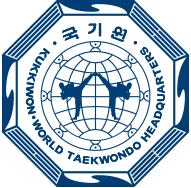Taekwondoin (people who practice Taekwondo) are lined up according to seniority (as Koreans consider seniority frequently throughout their daily lives). The beginner student wears a pure white belt. Each time they test successfully (see Promotion Tests for more information) they receive a rank promotion. Initially the student gets a coloured stripe on the same coloured belt as their current one. Then on the next test they get the full colour new belt. Each one is considered a full rank though (i.e. a stripe isn't considered a half-grade, it's a full rank in itself).
The order of the coloured belts (called kup ranks in Korean and counting up from 10th Kup to 1st Kup) are:
White belt 10th Kup
Is the colour of the absolute core of the Earth. At this point there is no life, only heat and excitement. White belt is given to beginner students and is the only rank not tested for.
Yellow tag (9th Kup), Yellow belt (8th Kup)
The colour of the cooling outer cores of the Earth. This is still an early stage where the student is only just getting used to the routine of Taekwondo and life in the club (or dojang in Korean)
Green tag (7th Kup), Green belt (6th Kup)
This is the colour of the grass. An exciting period for the student as they are feeling that a lot of techniques are now starting to click. This is the period where most students start to feel like they "get it", it's all making sense.
Blue tag (5th Kup), Blue belt (4th Kup)
This is the colour of the sky. Students are literally taking flight now as they are often able to start helping lower grades or demonstrating techniques under the watchful eye of an instructor.
Red tag (3rd Kup), Red belt (2nd Kup)
Red is the heat of the sun. Taekwondoin at red belt stages are in the last ranks of the kup system and are preparing for their junior-instructor level ranks. Time here should be spent polishing all techniques as there shouldn't be weak areas as they pass 1st Kup.
Black tag (1st Kup), "Black" belt
Black is the vastness of space. Given the size of the earth and space this represents how far when they look back the student has come but that black belt is the beginner of a whole new and much larger journey. While 15 year olds get a full back belt (or dan in Korean) starting at 1st Dan and working up to 9th Dan, under 15 year olds get a half-red/half-black belt (or poom in Korean) to show that they have achieved the rank but don't have the physical maturity.
Students under 15 can achieve up to 3rd Poom and when they reach 15 they may swap the certificate/rank for a 3rd Dan. When a student achieves 4th Dan they earn the title of "Master" and the Kukkiwon gives them the right to promote students to 3rd Dan (and one grade below themselves as they progress through higher dan ranks). When a master reaches 7th/8th Dan he may be given the title "Grandmaster" by another Grandmaster.
Changmookwan Ranks
Our Head Instructor has been given the right to promote practitioners to Changmookwan Dan rank through the World Taekwondo Changmookwan Federation under direct authority from the current Changmookwan President Kim Joong Young. While these rank certificates aren't as official as Kukkiwon rank, for those that want to obtain/maintain a link with a traditional school in Korea, they are a useful way of becoming part of a wider Taekwondo family.
This certification is available to any in the UK, not just students of Stevenage Taekwondo Club. For more information, visit the Changmookwan UK web site, contact Grandmaster Jeffries at [email protected].
A link to download the Changmookwan Dan application form is available on our Downloads page.



